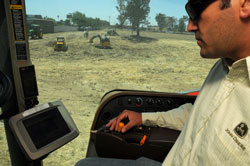
Borg Farm family and friends enjoy a campfire break from the rigors of 24/7 farming
Debbie Borg blogs about issues of technology and food from her Borg Farm base near Allen, Nebraska. In a recent post of “Random Thoughts,” she spoke of the great achievements of agricultural technology and the production efficiencies it has helped achieve.
Agriculture’s efficiency just seems to keep getting better and many of the activists groups want us to go back to the ‘old ways’. Why is it, after only a few days our computer needs to be updated, but farmers aren’t suppose to update to new technology. Read here that “To produce one billion kilograms of milk in 2007, we need 20 percent less cows, 25 percent less feed, 10 percent less land. In 2007, we produced 40 percent less methane and 56 percent less nitrous oxide compared to 1944. The reason for that is improved efficiency, and these are huge gains.
The Ad Council is teaming up with HSUS to launch a three-year, $80-120 million effort to change the way Americans view shelter pets and boost adoption rates of homeless cats and dogs across the country. Maybe why this campaign is being developed is that too many people have forgotten that pets are an animal that must be cared for daily. Unlike farmers and ranchers who have chosen a field of work that requires a commitment 24/7. Not everyone is designed to be a farmer or rancher–it takes special character and commitment.
Hats off and and kudos to Debbie (who’s Twitter handle is “iamafarmer2”) and Borg Farms for adding realism to the technology and food debate, and to Nebraska Corn Kernels blog also for highlighting their efforts. It’s awesome to see farmers take a more active role in helping promote their cause — to educate some consumers who think hobby farms and free-range livestock can feed a growing world.
And to that end of helping educate consumers and speaking up for agriculture, check out Michele Payn-Knoper’s blog called “Cause Matters.”

 To help reduce excessive nitrates from manure,
To help reduce excessive nitrates from manure,  The
The  Losses of up to $2 billion per year (10%) in soybean yield is due to rising surface ozone, according to satellite measurements by NASA,
Losses of up to $2 billion per year (10%) in soybean yield is due to rising surface ozone, according to satellite measurements by NASA, 
 I’ve had the opportunity to work on a project for John Deere that involves their new utility tractors and vehicles this year called the
I’ve had the opportunity to work on a project for John Deere that involves their new utility tractors and vehicles this year called the  While anti-agriculture naysayers continue to blast away at GM crops as the end of the world, it’s our duty to offer sound science to the discussion.
While anti-agriculture naysayers continue to blast away at GM crops as the end of the world, it’s our duty to offer sound science to the discussion. If you’ve heard news about potential failure of satellites in the
If you’ve heard news about potential failure of satellites in the